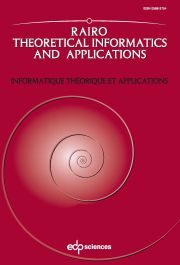Crossref Citations
This article has been cited by the following publications. This list is generated based on data provided by Crossref.
JUSTIN, JACQUES
and
PIRILLO, GIUSEPPE
2004.
EPISTURMIAN WORDS: SHIFTS, MORPHISMS AND NUMERATION SYSTEMS.
International Journal of Foundations of Computer Science,
Vol. 15,
Issue. 02,
p.
329.
Edson, Marcia
and
Zamboni, Luca Q.
2004.
On representations of positive integers in the Fibonacci base.
Theoretical Computer Science,
Vol. 326,
Issue. 1-3,
p.
241.
Kocábová, Petra
Masáková, Zuzana
and
Pelantová, Edita
2005.
Integers with a maximal number of Fibonacci representations.
RAIRO - Theoretical Informatics and Applications,
Vol. 39,
Issue. 2,
p.
343.
Charlier, Émilie
Rampersad, Narad
and
Shallit, Jeffrey
2011.
Developments in Language Theory.
Vol. 6795,
Issue. ,
p.
165.
CHARLIER, ÉMILIE
RAMPERSAD, NARAD
and
SHALLIT, JEFFREY
2012.
ENUMERATION AND DECIDABLE PROPERTIES OF AUTOMATIC SEQUENCES.
International Journal of Foundations of Computer Science,
Vol. 23,
Issue. 05,
p.
1035.
Edson, Marcia
2013.
Calculating the numbers of representations and the Garsia entropy in linear numeration systems.
Monatshefte für Mathematik,
Vol. 169,
Issue. 2,
p.
161.
Leroy, Julien
Rigo, Michel
and
Stipulanti, Manon
2017.
Counting the number of non-zero coefficients in rows of generalized Pascal triangles.
Discrete Mathematics,
Vol. 340,
Issue. 5,
p.
862.
Frid, Anna E.
2018.
Sturmian numeration systems and decompositions to palindromes.
European Journal of Combinatorics,
Vol. 71,
Issue. ,
p.
202.
Bonardo, Pierre
Frid, Anna E.
and
Shallit, Jeffrey
2019.
The number of valid factorizations of Fibonacci prefixes.
Theoretical Computer Science,
Vol. 775,
Issue. ,
p.
68.
Shallit, Jeffrey
2021.
Robbins and Ardila meet Berstel.
Information Processing Letters,
Vol. 167,
Issue. ,
p.
106081.
Chow, Sam
and
Slattery, Tom
2021.
On Fibonacci partitions.
Journal of Number Theory,
Vol. 225,
Issue. ,
p.
310.
Shallit, Jeffrey
and
Shan, Sonja Linghui
2023.
A General Approach to Proving Properties of Fibonacci Representations via Automata Theory.
Electronic Proceedings in Theoretical Computer Science,
Vol. 386,
Issue. ,
p.
228.




